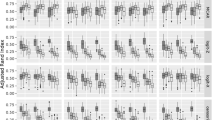Abstract
It is shown that for discrete objects constructed on bounded samples there are examples that support the faithfulness assumption and examples for which it fails. Thus, the properties of separation procedures for continuous models do not hold for discrete objects.
Similar content being viewed by others
References
J. Pearl, Causality: Models, Reasoning, and Inference, Cambridge Univ. Press (2000).
P. Spirtes, C. Glymour, and R. Scheines, Causation, Prediction, and Search, MIT Press, New York (2001).
R. E. Neapolitan, Learning Bayesian Networks, Prentice Hall, NJ, Upper Saddle River (2004).
I. V. Sergienko, A. M. Gupal, and A. A. Vagis, “Symmetry in encoding genetic information in DNA,” Cybern. Syst. Analysis, 47, No. 3, 408–414 (2011).
I. V. Sergienko, A. M. Gupal, and A. A. Vagis, “Symmetry and properties of encoding information in DNA,” Dokl. NANU, Vol. 439, No. 1, 30–32 (2011).
V. Boss, Lectures in Mathematics, Vol. 12, Counterexamples and Paradoxes. A Handbook, Knizhnyi Dom Librokom, Moscow (2009).
Author information
Authors and Affiliations
Corresponding author
Additional information
Translated from Kibernetika i Sistemnyi Analiz, No. 1, January–February, 2013, pp. 43–48.
Rights and permissions
About this article
Cite this article
Gupala, A.M., Gupala, N.A. Properties of separation procedures for discrete objects in Bayesian network models. Cybern Syst Anal 49, 36–40 (2013). https://doi.org/10.1007/s10559-013-9482-7
Received:
Published:
Issue Date:
DOI: https://doi.org/10.1007/s10559-013-9482-7




